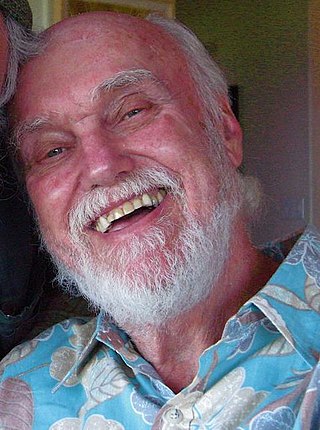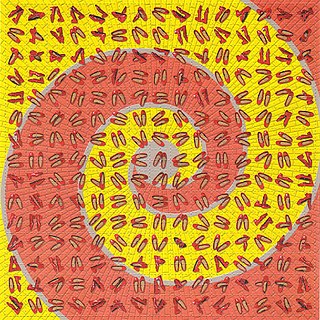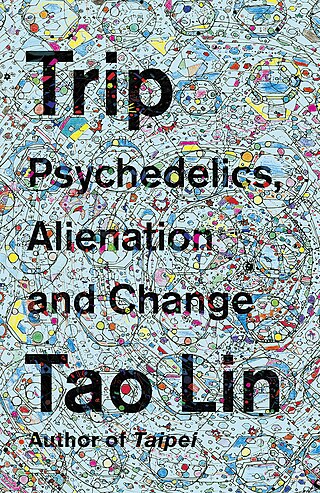
Timothy Francis Leary was an American psychologist and author known for his strong advocacy of psychedelic drugs. Evaluations of Leary are polarized, ranging from bold oracle to publicity hound. According to poet Allen Ginsberg, he was "a hero of American consciousness", and writer Tom Robbins called him a "brave neuronaut". During the 1960s and 1970s, Leary was arrested 36 times. President Richard Nixon called him "the most dangerous man in America".

Psilocybin is a naturally occurring psychedelic prodrug compound produced by more than 200 species of fungi. The most potent are members of genus Psilocybe, such as P. azurescens, P. semilanceata, and P. cyanescens, but psilocybin has also been isolated from approximately a dozen other genera. Psilocybin is itself biologically inactive but is quickly converted by the body to psilocin, which has mind-altering effects similar, in some aspects, to those of lysergic acid diethylamide (LSD), mescaline, and dimethyltryptamine (DMT). In general, the effects include euphoria, visual and mental hallucinations, changes in perception, distorted sense of time, and perceived spiritual experiences. It can also cause adverse reactions such as nausea and panic attacks.

Psychedelia usually refers to a style or aesthetic that is resembled in the psychedelic subculture of the 1960s and the psychedelic experience produced by certain psychoactive substances. This includes psychedelic art, psychedelic music and style of dress during that era. This was primarily generated by people who used psychedelic drugs such as LSD, mescaline and psilocybin and also non-users who were participants and aficionados of this subculture. Psychedelic art and music typically recreate or reflect the experience of altered consciousness. Psychedelic art uses highly distorted, surreal visuals, bright colors and full spectrums and animation to evoke, convey, or enhance the psychedelic experience.

Ram Dass, also known as Baba Ram Dass, was an American spiritual teacher, guru of modern yoga, psychologist, and writer. His best-selling 1971 book Be Here Now, which has been described by multiple reviewers as "seminal", helped popularize Eastern spirituality and yoga in the West. He authored or co-authored twelve more books on spirituality over the next four decades, including Grist for the Mill (1977), How Can I Help? (1985), and Polishing the Mirror (2013).

Psilocybin mushrooms, commonly known as magic mushrooms or shrooms, are a polyphyletic informal group of fungi that contain psilocybin, which turns into psilocin upon ingestion. Biological genera containing psilocybin mushrooms include Psilocybe, Panaeolus, Inocybe, Pluteus, Gymnopilus, and Pholiotina.
Psychedelic therapy refers to the proposed use of psychedelic drugs, such as psilocybin, MDMA, LSD, and ayahuasca, to treat mental disorders. As of 2021, psychedelic drugs are controlled substances in most countries and psychedelic therapy is not legally available outside clinical trials, with some exceptions.

The psychedelic drug lysergic acid diethylamide (LSD) was first synthesized on November 16, 1938, by the Swiss chemist Albert Hofmann in the Sandoz laboratories in Basel, Switzerland. It was not until five years later on April 19, 1943, that the psychedelic properties were found. Today, the discovery of LSD is celebrated worldwide during the annual Bicycle Day holiday, serving also as the day celebrating the psychedelic revolution in general.
A psychedelic experience is a temporary altered state of consciousness induced by the consumption of a psychedelic substance. For example, an acid trip is a psychedelic experience brought on by the use of LSD, while a mushroom trip is a psychedelic experience brought on by the use of psilocybin. Psychedelic experiences feature alterations in normal perception such as visual distortions and a subjective loss of self-identity, sometimes interpreted as mystical experiences. Psychedelic experiences lack predictability, as they can range from being highly pleasurable to frightening. The outcome of a psychedelic experience is heavily influenced by the person's mood, personality, expectations, and environment.

The Harvard Psilocybin Project was a series of experiments aimed at exploring the effects of psilocybin intake on the human mind conducted by Timothy Leary and Richard Alpert. The founding board of the project consisted of Leary, Aldous Huxley, David McClelland, Frank Barron, Ralph Metzner, and two graduate students who were working on a project with mescaline.

The Marsh Chapel Experiment, also called the "Good Friday Experiment", was an experiment conducted on Good Friday, April 20, 1962 at Boston University's Marsh Chapel. Walter N. Pahnke, a graduate student in theology at Harvard Divinity School, designed the experiment under the supervision of Timothy Leary, Richard Alpert, and the Harvard Psilocybin Project. Pahnke's experiment investigated whether psilocybin would act as a reliable entheogen in religiously predisposed subjects.

The Concord Prison Experiment, conducted from 1961 to 1963, was designed to evaluate whether the experiences produced by the psychoactive drug psilocybin, derived from psilocybin mushrooms, combined with psychotherapy, could inspire prisoners to leave their antisocial lifestyles behind once they were released. How well it worked was to be judged by comparing the recidivism rate of subjects who received psilocybin with the average for other Concord inmates.
Michael Hollingshead (?–1984?) was a British researcher who studied psychedelic drugs, including psilocybin and LSD, at Harvard University in the mid-20th century. He was the father of comedian Vanessa Hollingshead. He evangelized the use of LSD to many notable figures.
Ego death is a "complete loss of subjective self-identity". The term is used in various intertwined contexts, with related meanings. Jungian psychology uses the synonymous term psychic death, referring to a fundamental transformation of the psyche. In death and rebirth mythology, ego death is a phase of self-surrender and transition, as described by Joseph Campbell in his research on the mythology of the Hero's Journey. It is a recurrent theme in world mythology and is also used as a metaphor in some strands of contemporary western thinking.
Walter Norman Pahnke was a minister, physician, and psychiatrist most famous for the "Good Friday Experiment", also referred to as the Marsh Chapel Experiment or the "Miracle of Marsh Chapel".

League for Spiritual Discovery (LSD) was a spiritual organization inspired by the works of Timothy Leary, and strove for legal use of lysergic acid diethylamide (LSD) for the purpose of meditation, insight, and spiritual understanding. It was in existence during the mid-to-late 1960s, and eventually closed by Leary. The New York Center for the League of Spiritual Discovery, in existence for around a year, was co-founded by Timothy Leary and Nina Graboi in 1966. The center was the first LSD-based meditation center in Manhattan.

The Psychedelic Experience: A Manual Based on The Tibetan Book of the Dead is a 1964 book about using psychedelic drugs that was coauthored by Timothy Leary, Ralph Metzner and Richard Alpert. All three authors had taken part in research investigating the therapeutic potential of psychedelic drugs such as LSD, psilocybin and mescaline in addition to the ability of these substances to sometimes induce religious and mystical states of consciousness.
The Leary–Lettvin debate was a May 3, 1967 debate between Jerome Lettvin, a medical doctor and professor at MIT, and Timothy Leary, a licensed psychologist, about the merits and dangers of the hallucinogenic drug LSD. It took place in the Kresge Auditorium at the Massachusetts Institute of Technology.
Philosophy of psychedelics is the philosophical investigation of the psychedelic experience. While psychedelic, entheogenic or hallucinogenic substances have been used by many traditional cultures throughout history mostly for religious purposes, recorded philosophical speculation and analysis of these substances, their phenomenological effects and the relevance of these altered states of consciousness to philosophical questions is a relatively late phenomenon in the history of philosophy. Traditional cultures who use psychedelic substances such as the Amazonian and Indigenous Mexican peoples hold that ingesting medicinal plants such as Ayahuasca and Peyote allows one to commune with the beings of the spirit world.

Trip: Psychedelics, Alienation, and Change is a 2018 nonfiction book by Tao Lin. It is his first nonfiction book, and eighth book total.
Entheogenic drugs have been used by various groups for thousands of years. There are numerous historical reports as well as modern, contemporary reports of indigenous groups using entheogens, chemical substances used in a religious, shamanic, or spiritual context.











